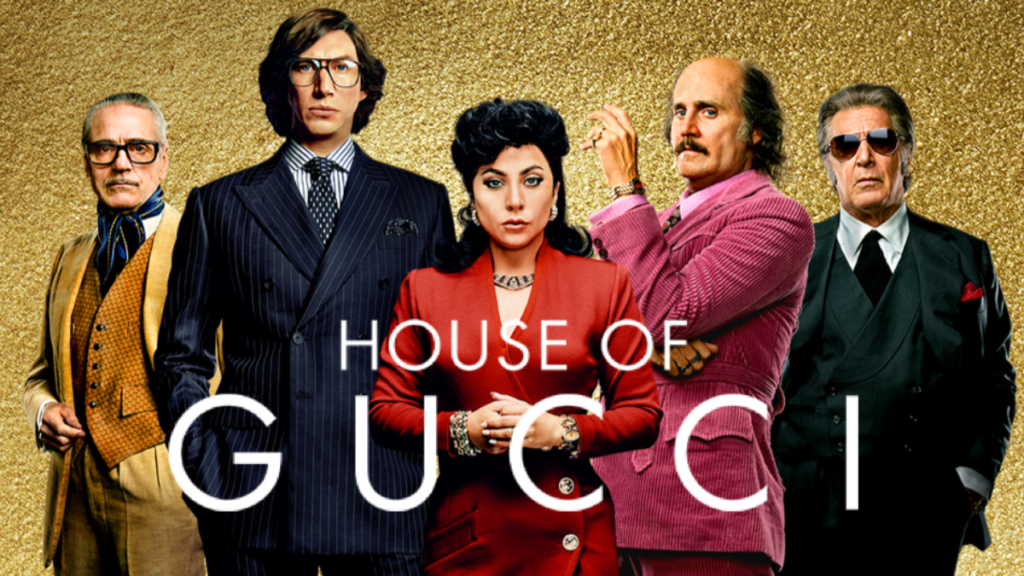“House of Gucci” is a cinematic masterpiece that delves into the tumultuous history of the renowned Gucci fashion empire. Directed by Ridley Scott, the film explores the family’s rise to global prominence, highlighting the struggles for control and the emotional toll of success and power. The film features stellar performances from Lady Gaga as Patrizia Reggiani, Adam Driver as Maurizio, and Jared Leto as Paolo Gucci. The film also explores the enduring legacy of the Gucci family, serving as a cautionary tale for those ensnared by the trappings of power and wealth. The film leaves viewers with echoes of a bygone era, a tale of passion, betrayal, and the enduring legacy of the House of Gucci.
The Allure of Gucci: Setting the Stage for Intrigue
Gucci, a name synonymous with luxury and sophistication, has a storied history dating back to its humble beginnings in Florence, Italy. The film opens a window into the world of fashion, portraying the rise of the Gucci family and their ascent to global prominence. As the narrative unfolds, the audience is not merely spectators but participants in a journey through time, exploring the evolution of a brand that became synonymous with status and style.
Character Portrayals: Stellar Performances Bringing the Gucci Saga to Life
Central to the film’s success are the stellar performances of the cast, with Lady Gaga leading the ensemble as Patrizia Reggiani, the ex-wife of Maurizio Gucci. Adam Driver portrays the ambitious Maurizio, whose complex character navigates love, power, and betrayal. The chemistry between Lady Gaga and Driver is palpable, adding depth to the characters and making the audience emotionally invested in the tumultuous love story that unfolds.
Jared Leto’s transformative performance as Paolo Gucci, Maurizio’s cousin, provides a memorable and often comedic element to the film. Leto’s commitment to his role, both physically and emotionally, showcases the lengths actors go to in order to bring authenticity to their characters.
A Tale of Love and Betrayal: The Gucci Family Drama Unfolds
At its core, “House of Gucci” is a tale of love gone awry and the subsequent betrayal that rocks the foundations of the iconic fashion house. The film meticulously explores the intricate relationships within the Gucci family, depicting the struggles for control and the emotional toll that success and power can exact. Patrizia’s character, in particular, serves as a lens through which the audience witnesses the internal strife that threatens to tear the family apart.
The film invites viewers to reflect on the consequences of unchecked ambition and the high price of success in the cutthroat world of fashion. The script does not shy away from portraying the darker aspects of the Gucci legacy, shedding light on the scandals and controversies that have marred the brand’s illustrious history.
Visual Splendor: Cinematic Brilliance and Costume Design
Ridley Scott’s masterful direction is complemented by the visually stunning cinematography that captures the essence of each era portrayed in the film. From the glamorous excesses of the 1980s to the more somber tones of the 1990s, the cinematography serves as a visual time capsule, immersing the audience in the changing landscapes of both the Gucci family and the fashion industry.
Moreover, the film’s costume design, led by Janty Yates, deserves special mention. The meticulous attention to detail in recreating iconic Gucci looks from different decades contributes to the film’s authenticity. Lady Gaga’s wardrobe, in particular, is a spectacle in itself, showcasing the evolution of fashion trends and the enduring allure of the Gucci brand.
Legacy and Lessons: The Aftermath of the Gucci Drama
As the credits roll and the audience reflects on the cinematic journey, “House of Gucci” prompts contemplation about the enduring legacy of the Gucci name. The film’s exploration of family dynamics, corporate greed, and the fragility of success serves as a cautionary tale for those ensnared by the trappings of power and wealth.
While the Gucci family’s saga is undeniably dramatic, it serves as a microcosm of the challenges faced by many iconic brands and their founders. The film invites viewers to question the cost of success and the sacrifices made in the pursuit of excellence, leaving lingering thoughts about the true price of achieving and maintaining a coveted place in the world.
Conclusion: A Cinematic Triumph and a Glimpse into Fashion History
“House of Gucci” emerges not only as a compelling narrative about one of the most influential fashion families but also as a triumph of cinematic storytelling. Ridley Scott, along with a stellar cast and crew, brings to life a captivating saga that transcends the boundaries of time and space, inviting audiences to witness the highs and lows of a legendary fashion empire.
As viewers leave the theater, they carry with them the echoes of a bygone era, a tale of passion, betrayal, and the enduring legacy of a name that continues to resonate in the world of high fashion—the House of Gucci.







